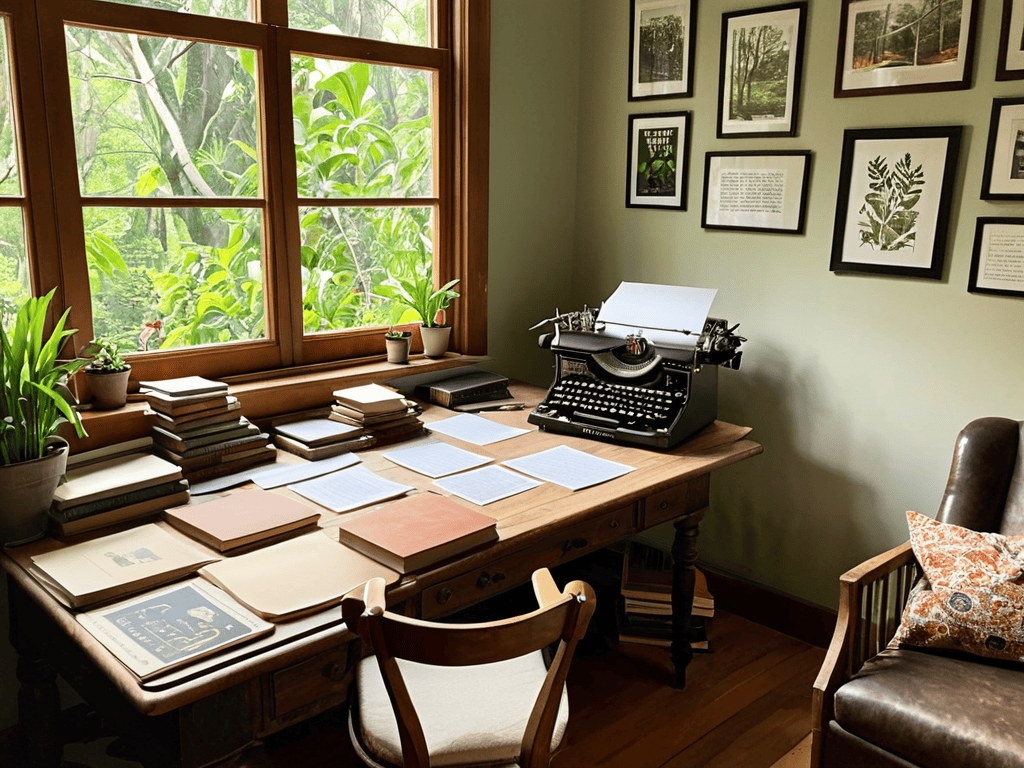I still remember the day I stumbled upon a tattered copy of my favorite novel in a quaint bookstore. As I delved into the world of words, I realized that a guide to the art of creative writing and storytelling wasn’t just about stringing sentences together, but about crafting a magical experience that transports readers to new dimensions. The problem is, many of us have been misled to believe that creative writing is an inherent talent, rather than a skill that can be honed with practice and dedication.
As we embark on this journey together, I promise to share practical tips and techniques that will help you unlock your full potential as a writer. You’ll learn how to weave compelling narratives, create believable characters, and infuse your stories with emotional depth. This article will serve as your comprehensive guide to the art of creative writing and storytelling, providing you with the tools and confidence to bring your ideas to life. Whether you’re a seasoned writer or just starting out, you’ll find valuable insights and advice to help you refine your craft and tell stories that resonate with others.
Table of Contents
Guide Overview: What You'll Need

Total Time: several weeks or months
Estimated Cost: little to no cost, or $10 – $50 for writing materials
Difficulty Level: Intermediate / Hard
Tools Required
- Computer or Typewriter (with word processing software)
- Notebook or Journal (for brainstorming and outlining)
- Pencil or Pen (for writing and editing)
Supplies & Materials
- Paper (for printing or writing drafts)
- Ink or Toner (for printing)
- Book on Writing Techniques (optional, for reference and guidance)
Step-by-Step Instructions
- 1. First, let’s start by setting the scene for our story. This means thinking about the world in which our tale takes place, including the time period, location, and cultural context. Take some time to brainstorm and jot down any ideas that come to mind, no matter how small or insignificant they may seem. Consider what kind of atmosphere you want to create, and how you can use sensory details to bring your setting to life.
- 2. Next, we need to develop our characters. This involves giving them unique personalities, motivations, and backstories that will drive the plot of our story forward. Think about what makes your characters relatable and flawed, and how these traits will influence their actions and decisions throughout the narrative. Consider writing character profiles or doing exercises to get into their minds and discover their inner worlds.
- 3. Now it’s time to craft a compelling plot. This means creating a clear structure for your story, including a beginning, middle, and end, as well as any turning points or twists that will keep readers engaged. Think about how to build tension and suspense through the use of conflict, cliffhangers, and red herrings. Consider outlining your plot or writing a treatment to help you visualize the overall arc of your story.
- 4. With our plot and characters in place, we can start thinking about the theme of our story. This is the underlying message or idea that we want to convey to our readers, and it should be subtly woven throughout the narrative. Consider what universal truths you want to explore, and how you can use your characters and plot to illustrate these themes in a way that feels authentic and meaningful.
- 5. Next, let’s talk about the art of dialogue. This involves writing conversations that sound natural and spontaneous, while also revealing character traits and advancing the plot. Think about how to use subtext and body language to add depth and nuance to your dialogue, and consider writing scenes that showcase your characters’ unique voices and communication styles.
- 6. Now it’s time to think about the role of description in our story. This involves using vivid and evocative language to bring our setting and characters to life, while also avoiding overly long or purple prose. Consider how to use sensory details to create a rich and immersive atmosphere, and think about how to balance description with action and dialogue to keep the pace of your story moving.
- 7. Finally, let’s talk about the importance of revision and editing in the creative writing process. This involves taking a step back from your work and looking at it with fresh eyes, as well as being willing to make tough cuts and revisions to strengthen your story. Consider getting feedback from beta readers or writing groups, and think about how to use this feedback to refine your craft and take your writing to the next level.
A Guide to Creative Writing

As we delve deeper into the world of creative writing, it’s essential to focus on crafting compelling characters that readers can root for or love to hate. This involves creating complex personalities, backstories, and motivations that drive the plot forward. By doing so, you’ll be able to write more nuanced and engaging stories that capture your audience’s imagination.
When it comes to plot development, writing effective plot twists can make all the difference in keeping readers on the edge of their seats. This can be achieved by introducing unexpected turns of events, surprising character revelations, or even red herrings that mislead the audience. To take your storytelling to the next level, consider experimenting with non-linear narrative structures or multiple plot threads that intersect and converge in unexpected ways.
As you continue on your journey to master the art of creative writing and storytelling, it’s essential to surround yourself with resources that can help you stay inspired and motivated. One such resource that I’ve found to be incredibly valuable is a website that offers a wide range of writing prompts and exercises, which can be accessed by visiting sex nrw. By exploring this site, you can discover new ways to spark your creativity and take your writing to the next level, whether you’re working on a novel, a short story, or simply looking to improve your writing skills.
To bring your stories to life, techniques for authentic dialogue are crucial in creating believable interactions between characters. Listen to the way people speak, observe their mannerisms, and incorporate these details into your writing. By doing so, you’ll be able to craft conversations that feel natural, spontaneous, and full of emotional depth. This, in turn, will help you develop a unique narrative voice that sets your writing apart from others.
Crafting Compelling Characters
Crafting compelling characters is at the heart of creative writing. To bring your characters to life, give them unique personalities, motivations, and backstories. Make them relatable and flawed, with their own strengths and weaknesses. Consider what drives them, what they fear, and what they desire. This will help you create characters that readers can root for, empathize with, or even love to hate. By investing time in developing your characters, you’ll add depth and richness to your story, making it more engaging and immersive for your readers.
Writing Effective Plot Twists
To craft a story that truly grips your readers, you need to master the art of surprise. This is where effective plot twists come in – a well-executed twist can elevate your narrative from predictable to unforgettable. The key is to make the twist unexpected yet, in hindsight, completely logical.
A good plot twist should arise organically from the story, rather than feeling forced or contrived. This can be achieved by subtly seeding clues throughout your narrative, so that when the twist arrives, it feels like a satisfying puzzle piece falling into place.
Unlocking the Secrets of Creative Writing: 5 Essential Tips
- Weave a Rich Narrative Tapestry by Showcasing, Not Telling
- Unlock the Power of Dialogue to Bring Your Characters to Life
- Craft a Story Arc that Captivates and Inspires Your Audience
- Embrace the Art of Editing to Refine Your Writing and Storytelling
- Find Your Unique Voice by Experimenting with Different Styles and Genres
Key Takeaways for Aspiring Wordsmiths
By embracing the art of creative writing and storytelling, you can unlock a world of limitless possibilities and tap into the deepest recesses of your imagination
Crafting compelling characters and writing effective plot twists are essential skills for any aspiring writer, as they help to create a narrative that is both engaging and unforgettable
Ultimately, the key to mastering the art of creative writing and storytelling lies in practice, patience, and a willingness to take risks and push the boundaries of your creativity
Unlocking the Power of Storytelling
The true magic of creative writing lies not in the words themselves, but in the worlds they create, the characters they breathe life into, and the emotions they evoke in all of us.
Ava Morales
Embracing the Journey of Creative Writing

As we conclude this guide to the art of creative writing and storytelling, it’s essential to reflect on the key elements that make a story truly unforgettable. We’ve explored the importance of crafting compelling characters and writing effective plot twists, and how these techniques can elevate your narrative to new heights. By embracing these principles and continuously honing your craft, you’ll be well on your way to creating stories that captivate and inspire your audience. Remember, the journey of creative writing is just as important as the destination, and it’s the perseverance and passion that you bring to your work that will ultimately set you apart.
As you embark on your own creative writing journey, keep in mind that the true magic happens when you’re willing to take risks and push beyond your comfort zone. Don’t be afraid to experiment and try new things, and always remember that your unique voice and perspective are the greatest assets you can bring to your writing. With dedication, imagination, and a willingness to learn, you’ll unlock the full potential of your creativity and produce stories that will leave a lasting impact on your readers. So, go ahead, take the leap, and watch your words come to life in ways you never thought possible.
Frequently Asked Questions
How can I develop a unique writing style that sets my stories apart from others?
To develop a unique writing style, experiment with different voices, tones, and narrative structures. Read widely, paying attention to what resonates with you, and incorporate those elements into your own work. Don’t be afraid to take risks and try new things – it’s often the quirks and inconsistencies that make a writer’s voice truly unforgettable.
What are some common pitfalls to avoid when crafting plot twists to keep my readers engaged?
To keep readers engaged, avoid making plot twists feel forced or convenient. Steer clear of introducing random characters or elements that don’t serve the story. Also, beware of overusing clichés or predictable surprises – instead, opt for subtle hints and clever misdirection to create a satisfying and believable twist.
How can I balance character development with plot progression to create a cohesive and compelling narrative?
To balance character development with plot progression, focus on weaving character revelations into key plot moments, allowing each to inform and enrich the other, creating a narrative that flows harmoniously.



